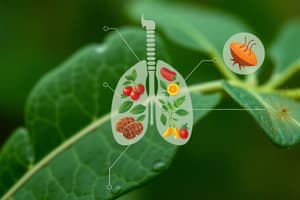Podcast
Questions and Answers
Dè tha CamScanner freagairteach do?
Dè tha CamScanner freagairteach do?
- Bidh e a' cruthachadh dhealbhan ann an stoidhle na h-eagal.
- Bidh e a' cruthachadh fhuasglaidhean matamataigeach.
- Bidh e a' leughadh leabharan tro a' ghriogair.
- Bidh e a' sganadh agus a' roinn sgrìobhainnean. (correct)
Ciamar a bheir CamScanner buannachd do luchd-cleachdaidh?
Ciamar a bheir CamScanner buannachd do luchd-cleachdaidh?
- Le bhith a' cruthachadh gluasadan ealaine.
- Le bhith a' sireadh fiosrachadh air loidhnichean.
- Le bhith a' sganadh sgrìobhainnean gu bheil e furasta an roinn. (correct)
- Le bhith a' cur air dòigh leabhraichean.
Cò a dh'fhaodadh a bhith freagairteach do CamScanner?
Cò a dh'fhaodadh a bhith freagairteach do CamScanner?
- Duine a tha ag iarraidh fiosrachadh mu deidhinn fhèin.
- Duine a tha ag iarraidh ealain a chruthachadh.
- Duine a tha a' coimhead air film.
- Duine a tha ag iarraidh sgrìobhainnean a sganadh. (correct)
Càite a bheir CamScanner an cothrom freagairteach?
Càite a bheir CamScanner an cothrom freagairteach?
Dè tha CamScanner a' gabhail ri?
Dè tha CamScanner a' gabhail ri?
Flashcards
CamScanner
CamScanner
Is e aplacaid a tha a' ceadachadh dhut sgrìobhainnean a sganadh agus an tionndadh gu faidhle didseatach.
Sganadh sgrìobhainnean
Sganadh sgrìobhainnean
Faodaidh tu sgrìobhainnean a sganadh bho dhiofar sheòrsaichean, leithid pàipear, leabhraichean, agus artaigilean.
Stòradh agus roinneadh
Stòradh agus roinneadh
Faodaidh tu na faidhlichean sganaidh a stòradh air do fhòn no an upload gu seirbheis chladaich.
Deasachadh sgrìobhainnean
Deasachadh sgrìobhainnean
Signup and view all the flashcards
Cruthachadh faidhlichean
Cruthachadh faidhlichean
Signup and view all the flashcards
Study Notes
Introduction to Life Processes
- Organisms must continuously maintain and repair their structures, even when not actively engaging in other activities.
- Energy is needed to support life processes. This energy is obtained from food (complex organic matter).
- Nutrition involves taking in food and utilizing it for various activities.
- Transportation moves digested food and oxygen to body cells.
- Respiration converts food into usable energy within cells. Waste products result from respiration and must be eliminated.
- Excretion is the process of removing these waste products from the body.
Characteristics of Living Organisms
- Cellular organisation: All living organisms are made up of cells.
- Sensitivity: organisms respond to stimuli (changes in the environment).
- Respiration: Living organisms produce energy from nutrients.
- Internal Growth: Living organisms grow inside, unlike some non-living things that grow outwards.
- Homeostasis: Organisms maintain a stable internal environment.
- Regulation: Organisms have mechanisms to coordinate their internal processes.
- Reproduction: Produce offspring.
- Metabolism: All chemical and physical changes within an organism.
Types of Metabolic Pathways
- Anabolic pathways: build complex substances from simpler ones (e.g., photosynthesis).
- Catabolic pathways: break down complex substances into simpler ones (e.g., respiration).
Nutrition in Unicellular and Multicellular Organisms
- Unicellular organisms: Life processes occur throughout the cell's surface since it is in direct contact with the environment.
- Multicellular organisms: Cells may not be in direct contact with the environment.
- Specialized organs and systems are needed to perform life processes.
Nutrition Modes
- Autotrophic: Organisms make their own food from simple inorganic substances (e.g., plants).
- Photosynthesis: The process where plants synthesize carbohydrates from carbon dioxide and water, using sunlight as energy.
- Light and dark reactions.
- Chlorophyll is needed.
- Heterotrophic: Organisms obtain food from other organisms (e.g., animals).
- Holozoic: Ingesting and digesting solid food (example: Amoeba).
- Saprotrophic: Obtaining nutrients from dead and decaying organic matter (e.g., fungi).
- Parasitic: Obtaining nutrients from a living host.
Nutrition in Humans - Digestive System
- Alimentary canal: The tube from mouth to anus.
- Mouth, oral cavity, pharynx, oesophagus, stomach, small intestine, large intestine, anus.
- Digestive glands: Produce juices that aid in digestion.
- Salivary glands, Gastric glands, Liver, Pancreas, and intestinal glands.
- Digestion: The mechanical and chemical breakdown of food.
- Types of teeth: Incisors, canines, premolars, molars.
- Functions of teeth: Biting, tearing, crushing, grinding.
- Absorption: Taking up digested food into the body.
- Assimilation: Using absorbed food for growth, repair, and energy.
Additional Information
- Importance of water for plants: Water is essential for photosynthesis, transportation, and various cellular processes.
- Effect of CO2 concentration on photosynthesis: Moderate levels are ideal and higher levels may negatively impact the process over time.
- Photosynthesis: Crucial for plant growth and energy production, releasing oxygen as a byproduct.
- Components of photosynthesis: Chlorophyll, carbon dioxide, sunlight, and water.
Studying That Suits You
Use AI to generate personalized quizzes and flashcards to suit your learning preferences.



